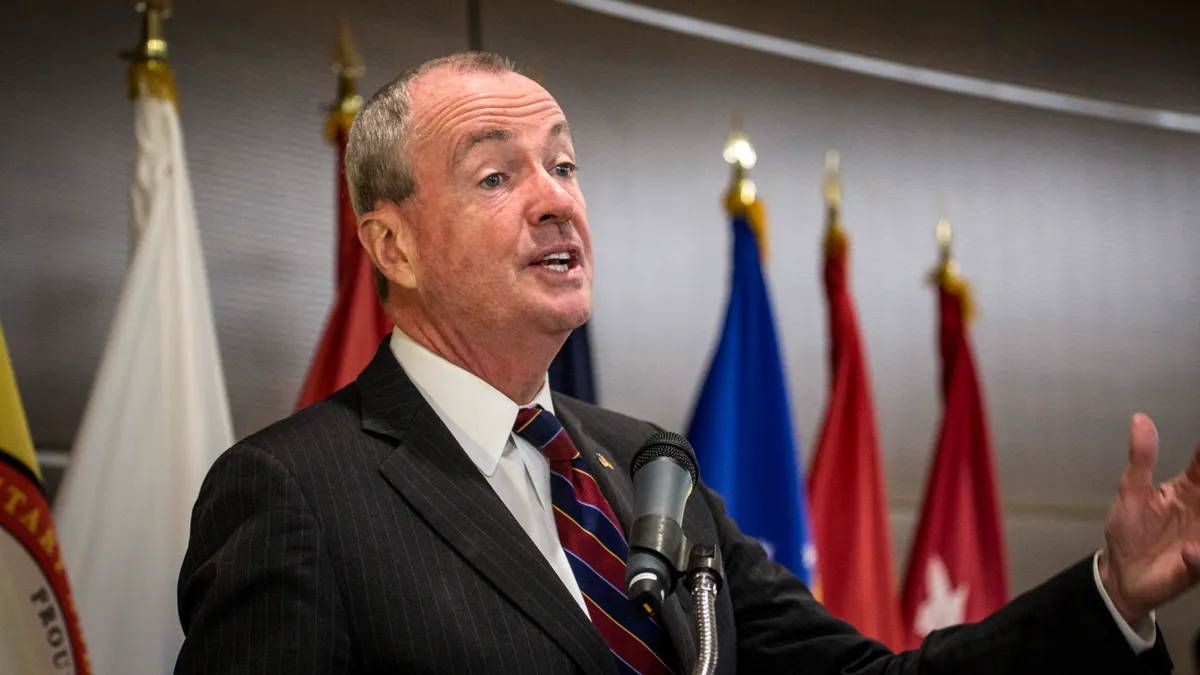Dive Brief:
-
New Jersey Gov. Phil Murphy released on Monday a wide-ranging plan with details on how the state could achieve 100% clean energy by 2050, a goal adopted by governors of both Massachusetts and Washington in the past month.
-
The governor's "Energy Master Plan" admits that New Jersey’s efforts to reduce greenhouse gas emissions thus far are insufficient to achieve the target of 80% reduction from 2006 levels set by the state’s Global Warming Response Act, passed last summer.
-
Major proposals in the plan include additional steps to ensure that 7.5 GW of offshore wind is part of New Jersey's energy mix by 2035. Murphy also announced proposals to have state regulators require utilities to explore "non-wire solutions" like storage and distributed energy resources (DERs) and establishing an electric vehicle "ecosystem" to build up EV charging infrastructure.
Dive Insight:
Murphy’s plan provides more specifics on how the state could meet its goals related to clean energy adoption based around seven areas: the transportation sector, renewable energy and DERs, energy efficiency, the building sector, the use of "integrated distribution plans," incentivizing clean energy in underserved communities and attracting supply chain businesses to create clean energy "clusters."
The Murphy administration had announced two major initiatives related to these areas: a November 2019 executive order set the goal of 7,500 MW of offshore wind by 2035, the second-largest such goal in the nation, and 2018 legislation aimed for 2,000 MW of energy storage by 2030.
On offshore wind, the plan calls for the New Jersey Board of Public Utilities to "develop a consistent and transparent solicitation schedule through 2035 that supports a steady, long-term Mid-Atlantic project pipeline. This procurement approach will enable long-term industry investment in core infrastructure and manufacturing facilities."
The plan is a "promising boost" for New Jersey’s offshore wind power industry, the National Wildlife Federation (NWF) said in a press release.
Beyond utility-scale projects like offshore wind, the plan also calls for a focus on distributed energy resources like rooftop solar. It calls upon state utilities to establish "integrated distribution plans" that will "allow for the anticipated growth of DER and EV charging on the electric distribution system," including changes in rate structures to encourage DERs.
Another strategy outlined by the governor looks at the state’s building sector, which accounts for 62% of New Jersey’s total end-use energy consumption, according to the plan. The document calls for New Jersey to "electrify its state facilities, partner with private industry to establish electrified building demonstration projects [and] expand and accelerate the current statewide net zero carbon homes incentive programs for both new construction and existing homes," among other measures.
The Consumer Energy Alliance, a group that represents business interests as well as large energy companies like ExxonMobil, criticized the plan for failing to present its costs. "While we support greater inclusion of renewable energy sources in New Jersey’s energy mix, it is highly worrisome that the state was unwilling to make the cost of this plan on ratepayers public," Consumer Energy Alliance Mid-Atlantic Director Mike Butler said in a statement.
The master plan recommendations are based on a report developed by the New Jersey Board of Public Utilities and the New Jersey Department of Environmental Protection along with contractors the Rocky Mountain Institute and Evolved Energy Research. The Integrated Energy Plan "identifies the optimal, least-cost approach to reach 100% clean energy by 2050 based on today’s most cost-effective technologies," according to the master plan.














